Stan Garfield's Blog, page 10
May 31, 2024
Knowledge Management Thought Leader 72: Tom Davenport
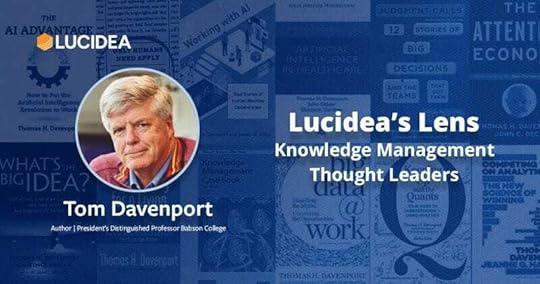
Tom Davenport is the President’s Distinguished Professor of Information Technology and Management at Babson College, a Fellow of the MIT Center for Digital Business, and an independent senior advisor to Deloitte Analytics.
An author and co-author of 20 books and more than 200 articles, he helps organizations to transform their management practices in digital business domains such as artificial intelligence, analytics, information and knowledge management, process management, and enterprise systems.
Tom pioneered the concept of “competing on analytics” with his best-selling 2006 Harvard Business Review article and 2007 book by the same name. Since then, he has continued to provide cutting-edge insights on how companies can use analytics and big data to their advantage, and then on artificial intelligence. Tom’s book Only Humans Need Apply: Winners and Losers in the Age of Smart Machines offers tangible tools for individuals who need to work with cognitive technologies. In The AI Advantage: How to Put the Artificial Intelligence Revolution to Work, he provides a guide to using artificial technologies in business. His latest book, All-in On AI: How Smart Companies Win Big with Artificial Intelligence provides leaders and their teams with the insights to help their own companies become AI-fueled.

For more about Tom, see Profiles in Knowledge.
Books How to Train Generative AI Using Your Company’s Data
How to Train Generative AI Using Your Company’s DataLeveraging a company’s proprietary knowledge is critical to its ability to compete and innovate, especially in today’s volatile environment. Organizational innovation is fueled through effective and agile creation, management, application, recombination, and deployment of knowledge assets and know-how. However, knowledge within organizations is typically generated and captured across various sources and forms, including individual minds, processes, policies, reports, operational transactions, discussion boards, and online chats and meetings. As such, a company’s comprehensive knowledge is often unaccounted for and difficult to organize and deploy where needed in an effective or efficient way.
Outline
The Technology for Generative AI-Based Knowledge ManagementTraining an LLM from ScratchFine-Tuning an Existing LLMPrompt-tuning an Existing LLMContent Curation and GovernanceQuality Assurance and EvaluationLegal and Governance IssuesShaping User BehaviorKnowledge of what types of content are available through the systemHow to create effective promptsWhat types of prompts and dialogues are allowed, and which ones are notHow to request additional knowledge content to be added to the systemHow to use the system’s responses in dealing with customers and partnersHow to create new content in a useful and effective mannerEverything Is Moving Very FastCompeting on Analytics: The New Science of Winning Analytics at Work: How to Make Better Decisions and Get Better Results
Analytics at Work: How to Make Better Decisions and Get Better ResultsFive levels and five factors for building analytical capability

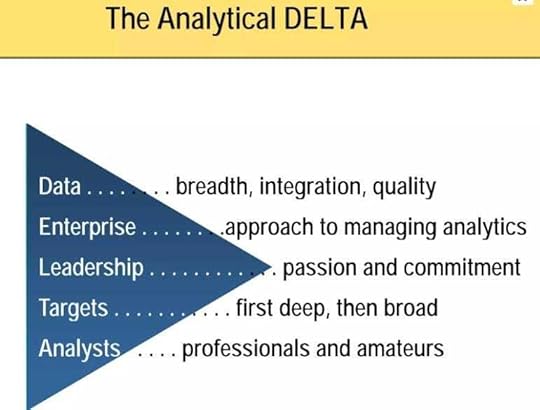 [image error]
[image error]
May 24, 2024
Knowledge Management Thought Leader 71: Rob Cross

Rob Cross is an author, professor, and researcher who has studied the underlying networks of effective organizations and the collaborative practices of high performers.
Working with more than 300 organizations and reaching thousands of leaders, he has identified specific ways to cultivate vibrant, effective networks at all levels of an organization and at any career stage.
He is Senior Vice President of Research at the Institute for Corporate Productivity (i4cp) and the Edward A. Madden Professor of Global Leadership at Babson College. Rob is also the co-founder and director of the Connected Commons, a consortium of over 150 leading organizations accelerating network research and practice. Rob specializes in agility, well-being, innovation, collaboration, and network analysis.

For more about Rob, see Profiles in Knowledge.
Books

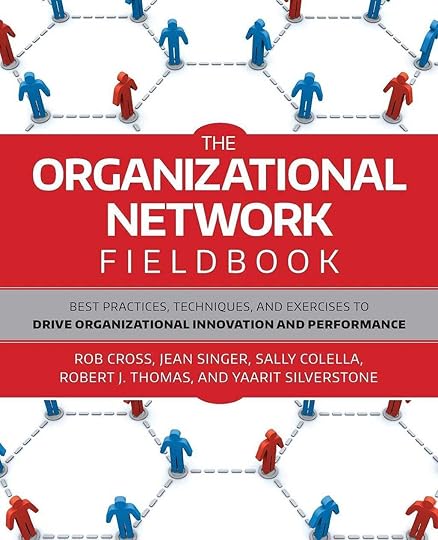
 Network Analysis Enhances Merger Integration
Network Analysis Enhances Merger Integration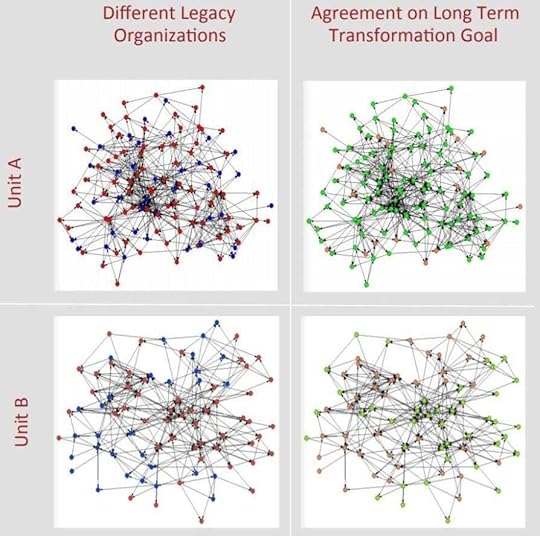
 5 Ways Successful Collaborators Reach Their GoalsFocus on your strengths.Focus on connections.Manage to your best rhythm of work.Sculpt your work to align with your objectives.Block time in your calendar for more-reflective work.Where We Go Wrong with Collaboration
5 Ways Successful Collaborators Reach Their GoalsFocus on your strengths.Focus on connections.Manage to your best rhythm of work.Sculpt your work to align with your objectives.Block time in your calendar for more-reflective work.Where We Go Wrong with CollaborationBy collaborating in a more purposeful fashion, the successful people I studied were 18–24% more efficient than their peers. In-depth interviews with more than 600 successful women and men showed how they accomplished this feat through three categories of behaviors:
Identifying and challenging beliefs that lead us to collaborate too quicklyImposing structure in our work to prevent unproductive collaborationAltering behaviors to create more efficient collaborationReflect on the statements below and consider which beliefs you need to guard against:
“My desire to help others makes me too easy an outlet for collaborative requests.”“My sense of fulfillment from accomplishment leads me to engage in collaborative work that creates overload.”“My desire to be influential or recognized for my expertise creates excessive reliance on me.”“My concern with being labeled a poor performer leads me to engage in collaborations that create overload.”“My need to be right leads me to spend too much time preparing for and engaging in collaborative activities.”“Fear of losing control of a project — or a belief that I am the most capable person to do the work well — keeps me from delegating tasks or connecting people around me.”“My need for closure results in communications that create unnecessary work and stress for others and drive future interactions back to me.”“My discomfort with ambiguity and managing adaptation as a project unfolds results in excessive collaborative work to overly perfect or obtain buy-in for a plan.”“FOMO drives me to engage in collaborative work that creates overload.”[image error]May 18, 2024
Knowledge Management Thought Leader 70: Jay Cross
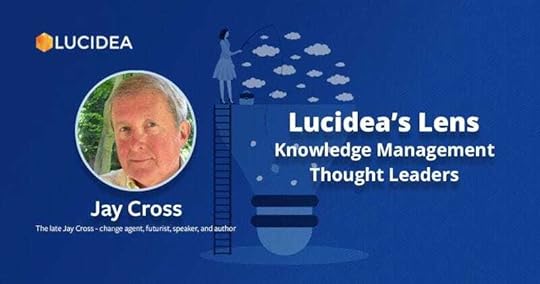
The late Jay Cross (1944–2015) championed the cause of informal learning in business settings. He was the Johnny Appleseed of informal learning. The Internet Time Alliance, which he chaired, helps corporations and governments use networks to accelerate performance.
Jay challenged conventional wisdom about how adults learn since designing the first business degree program offered by the University of Phoenix. A champion of systems thinking, Jay’s calling was to create happier, more productive workplaces. He was the first person to use the term “eLearning” on the web.
Jay was a change agent, futurist, speaker, and author. He distilled lessons from cognitive science, social networking, business strategy, futures research, and psychology.

For more about Jay, see Profiles in Knowledge.
Selected Books
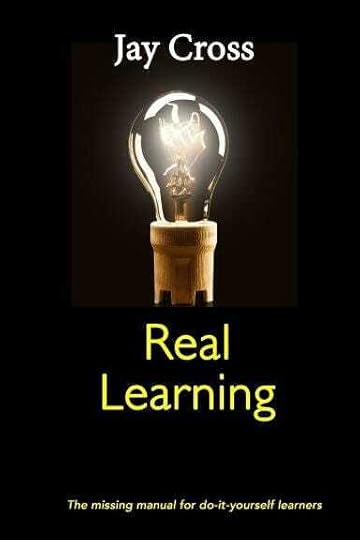
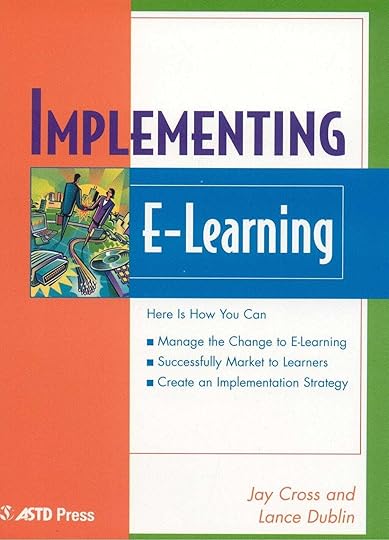 The Rise of Informal Learning
The Rise of Informal LearningResearch showed that 80+% of the way people learn their jobs is informal. I asked why, if Informal Learning was carrying more of the load, did organizations invest most of their spending on Learning and Development on formal learning? Profit oriented managers were intrigued, but they didn’t know what to do about it. It was an emperor’s new clothes moment.
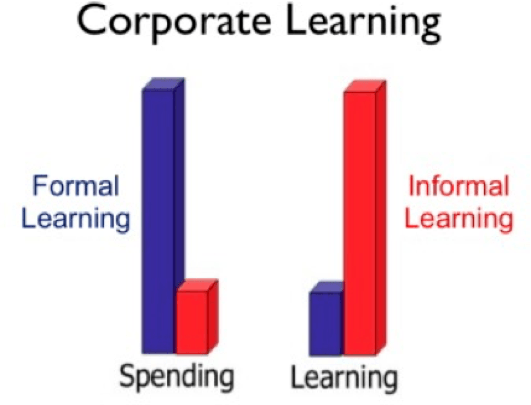
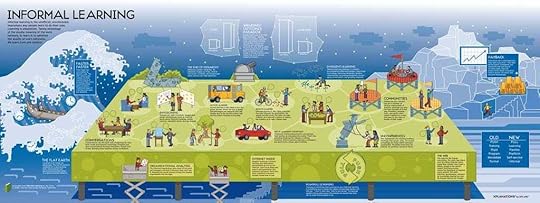 Real Learning: Learning For Everyone
Real Learning: Learning For Everyone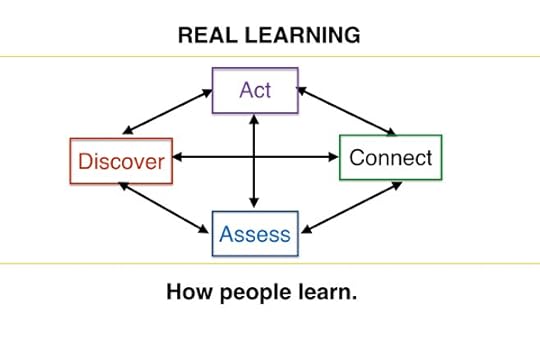
First Principles
Most learning is self-directed. Give people the freedom to chart their course. Make sure resources are readily available and easy to find.Set high expectations, and people live up to them. Help people make sense of and prosper in the world and the workplace. Facilitate social networks that enable people to compare their situation with others.Conversations are the stem cells of learning. Foster open, frequent, frank conversations both virtually and in person. Praise courageous conversations.People learn by doing. Encourage experimentation.Ensure that managers and mentors understand the impact of stretch assignments. Learning is experiential, and stretch assignments give learners new experiences.Teach people the least they need to know to tackle things on their own.Make it drop dead simple to access people in the know, the lessons of experience, how-to information, and performance support.Learning is social. Encourage participation in communities. Make collaboration the norm. Narrate your work and share with others. Communities and guilds create and consume knowledge. If you don’t have a vibrant social network, create one.More than half of us work part of our time outside of the office. Ensure support is mobile.We want what we want, no more. Whenever possible, provide choices. Give employees the pieces to create personalized learning experiences.Learning is for everyone, not just novices and up-and-comers. You can’t expect to prosper without it. Make sure everyone’s covered.Learning takes reinforcement to stick. Seek feedback. Blog, tweet, and otherwise share your reflections. Revisiting what you learn fixes it in memory.Innovation is born of mashing up concepts from different disciplines. Encourage looking outside the box.Provide feeds for what’s going on in the team, the department, the company, the industry, and technical disciplines.People confuse learning with school. Build lessons on learning how to learn into the organization.Real Learning: Bottom-Up Learning from the Top DownAn organization moving from a traditional structure to an organic one is in an ideal position to embed real learning and working smarter into its culture.
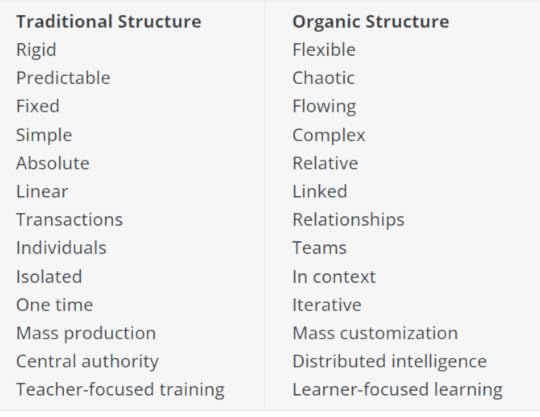 [image error]
[image error]
May 10, 2024
Knowledge Management Thought Leader 69: Paul Corney
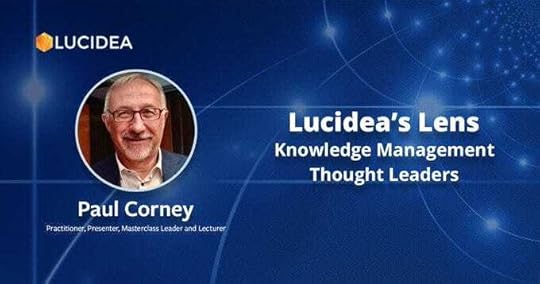
Paul Corney helps people and organizations make better decisions that improve the way they work, and helps them realize their potential by making the best use of their knowledge.
Paul came to knowledge management while working in the City of London in the mid-1990s. He is the founder of Knowledge et al, a UK-based KM consultancy and the former Managing Partner of Sparknow LLP.
Paul is an experienced practitioner, presenter, masterclass leader and lecturer. A member of the British Standards Institute KM Standards Committee (KMS/1), he was also a visiting lecturer on Brighton University’s MBA on Knowledge & Innovation.

For more about Paul, see Profiles in Knowledge.
Selected Books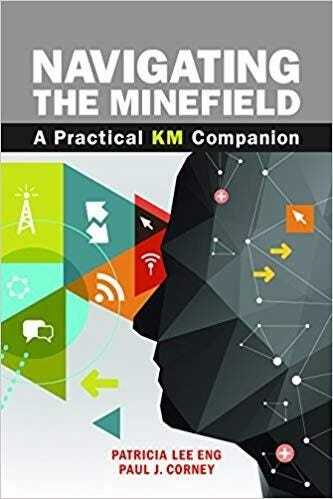
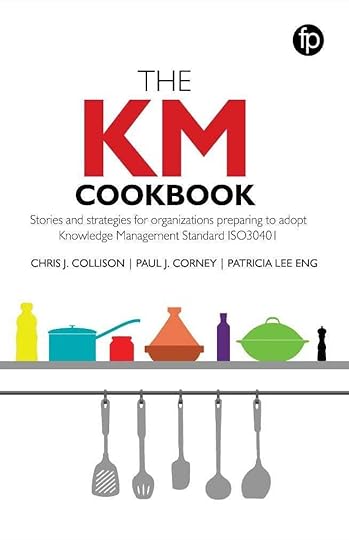 Managing Networks and Working Out Loud: Collaboration and Knowledge Matchmaking Skills
Managing Networks and Working Out Loud: Collaboration and Knowledge Matchmaking SkillsKnowledge Matchmaking?
Do people in Knowledge Management have the time, the confidence, and the knowledge of the business to be able to put forward ideas and broker connections? If they do, then here are a few tips to become a Knowledge Matchmaker:
You have to be in it to win it: if you sit on the sidelines this will never happen.Be willing to take a risk: yes you might fall flat on your face! But experience tells me that if you go the extra mile people will come back for more.Be willing to do this without expectation of reward: it’s always difficult to measure the impact in a world of KPI’s. You have to play a long game but be willing to cut if you feel you are being taken for a ride.Be willing to acknowledge the contribution of others: from personal experience I’ve found there is nothing worse than someone taking what you’ve suggested and packaging it without attribution. A photo is a great way of saying thank you!Build trust so people are willing to confide in you and trust your judgement: unless you are willing to find out about people and what they do you will never be able to make these connections.Be clear about why you are making the introduction or sharing Knowledge: I used to be in the cc camp that so many inhabit believing that by informing everyone I was covering all bases. People are too busy and ignore ‘junk mail’.Develop your internal filtering mechanism: you have to know your business and identify who is going to be a taker vs. a reciprocator.Respect the contribution people make if you ask for advice: whatever you get back from people is important. They have committed scarce time and each time you ask for a response you are drawing on your reserve of credibility.Develop a skin as thick as a Rhino: you will be disappointed when others don’t follow your lead and use the contacts or information without acknowledgement. And remember 90% of people online are lurkers so will not go public with their thanks.The future for Knowledge Managers?The Skills (‘…ates) of a Knowledgeur
Investigate: Are you putting a burning fire out / solving an immediate business need / addressing a risk (Operational KM) or is this driven by the vision from the top consistent with the organization’s business direction (Strategic KM)?Navigate: Work out / Map the critical knowledge areas of your organization and create a directory of the organization’s knowledge assets.Negotiate: Agree the scope of your role with your sponsors and be tough negotiating what success will look like and how it’s measured.Facilitate: So much of what a KM Manager does involves facilitation. You will become a hub knowing who to go to to ask if you don’t know yourself. You have to facilitate connections, meetings, interactions, events and communities. This requires resilience, a lot of social skills and a real understanding of cultural nuances.Collaborate: You are in alliance with business areas and occasionally external suppliers or partners. You have to be capable of virtual cross border collaboration.Communicate: Senior KMers tell you to devote 30% of your time to communicating what you do and getting feedback — it’s not just about broadcasting. Have your KM Elevator pitch always with you. Let all your stakeholders know what you are doing and why.Curate: So much of what passes for Knowledge Management is about creating and storing content and making it available for reuse. It’s more than the role formerly undertaken by Information Professionals and Librarians, here we are talking about being a custodian of organizational knowledge and organizational knowledge bases.Celebrate: The role can be a lonely one as reporting lines and sponsors change, yours is a cost not revenue line and the initial burst of enthusiasm fades. Collect stories, be prepared to acknowledge contributions, and celebrate successes.Reflections on the ISO Standard for Knowledge Management SystemsWhat does the standard cover?
It starts with an outline of the purpose of the standard, explaining why KM is important. It provides guiding principles and outlines the boundaries of KM.Section 3 defines knowledge and also knowledge managementSection 4 covers the KM system, understanding the organization and its context and how KM supports this; understanding the needs of stakeholders. It outlines the KM system: the knowledge development/life cycle; enablers (roles, processes, technologies, governance and culture)Section 5 covers leadership and governanceSection 6 covers planning and actions to address risks and opportunitiesThere are three annexes on: the knowledge spectrum; boundaries between KM and adjacent disciplines; and KM culture.Benefits of the standard
It provides a benchmark for your KM management system and a guide to those organizations that are new to KM to help them avoid common pitfalls.It gives knowledge managers leverage in their organizations.It gives KM legitimacy as a profession.Impact
The standard is like a new kitchen without the utensils, the crockery, cookbook; it’s down to those who use it to determine how it will work for them.We hope that it provides a globally accepted framework of what should be in a KM program and how it should be supported and assessed.We are looking forward to it being drawn on by organizations that value KM.Who will benefit?
Undoubtedly consultants will develop offerings that purport to help organizations to prepare for an ISO KM Standards Audit. If that helps to raise standards then surely that’s a positive.However, we see the real beneficiary being KM practitioners, current and future in those organizations such as the public sector for which ISO Standards are a core component of their quality measurements.[image error]May 4, 2024
Jay Chatzkel: Profiles in Knowledge

This is the 103rd article in the Profiles in Knowledge series featuring thought leaders in knowledge management. Jay Chatzkel is currently Principal Photographer at Jay Chatzkel Photography, based in New River, Arizona. He was Principal of Progressive Practices, where he assisted organizations in transforming themselves into knowledge-based, intelligent enterprises. This included working with organizations to develop skills and practices in the areas of merger and acquisition integration, intellectual capital, knowledge management, social media, leadership, collaboration, business process management, and performance measurement.
He served on the editorial boards of the Journal for Knowledge Management, the Journal of Intellectual Capital, and the International Journal of Knowledge-Based Development and has written extensively in the field. He is the author of three books. He specialized in intellectual capital, knowledge capital, mergers and acquisitions, knowledge management, business process reengineering, and quality management.
Background EducationHarvard Kennedy School — MA, Public Policy. 1990University of Wisconsin — MS Urban and Regional Planning, Urban Planning, 1987Bucknell University — Bachelor’s degree, Economics, 1966ExperienceProgressive Practices — Principal, 1995–PresentSchooley Mitchell — Strategic Partner, 2010–2014ProfilesLinkedInProgressive PracticesFacebookContentProgressive Practices: Building Knowledge-Based EnterprisesBlogSlideShare
EducationHarvard Kennedy School — MA, Public Policy. 1990University of Wisconsin — MS Urban and Regional Planning, Urban Planning, 1987Bucknell University — Bachelor’s degree, Economics, 1966ExperienceProgressive Practices — Principal, 1995–PresentSchooley Mitchell — Strategic Partner, 2010–2014ProfilesLinkedInProgressive PracticesFacebookContentProgressive Practices: Building Knowledge-Based EnterprisesBlogSlideShare1. Value Creation Integration Breakthroughs
Value Creation Integration Breakthroughs
2. Social Media Strategy to Transform Integrations
Social Media Strategy to Transform Integrations
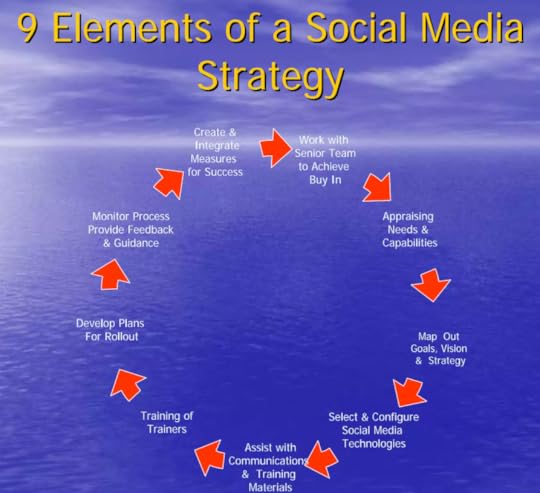 ArticlesGoogle ScholarEmerald InsightAcademia.eduSemantic ScholarKnowledge Management for CSR and Sustainability Performance: Renewing the Business Model Through Systematic Innovation for Value CreationThe Emergence of Contemporary Chinese Enterprise: The Heterogeneity of National Culture, Corporate Controls and Integration Approaches in M&AsDynamics of Chinese emerging multinationals in cross-border mergers and acquisitionsConference report 2006 KMWorld Conference ReviewQuantum leap breakthrough performance in acquisitions: The readiness and generative value approachTowards the next stage of intellectual capitalThe 1st World Conference on Intellectual Capital for Communities in the Knowledge Economy: Nations, Regions and CitiesGreater Phoenix as a Knowledge CapitalThe collapse of Enron and the role of intellectual capitalQuest for Excellence XII — the official conference of the Malcolm Baldrige National Quality Award
ArticlesGoogle ScholarEmerald InsightAcademia.eduSemantic ScholarKnowledge Management for CSR and Sustainability Performance: Renewing the Business Model Through Systematic Innovation for Value CreationThe Emergence of Contemporary Chinese Enterprise: The Heterogeneity of National Culture, Corporate Controls and Integration Approaches in M&AsDynamics of Chinese emerging multinationals in cross-border mergers and acquisitionsConference report 2006 KMWorld Conference ReviewQuantum leap breakthrough performance in acquisitions: The readiness and generative value approachTowards the next stage of intellectual capitalThe 1st World Conference on Intellectual Capital for Communities in the Knowledge Economy: Nations, Regions and CitiesGreater Phoenix as a Knowledge CapitalThe collapse of Enron and the role of intellectual capitalQuest for Excellence XII — the official conference of the Malcolm Baldrige National Quality AwardThe field of intellectual capital is at a crossroads. To move through the crossroads and to the next stage both practitioners and academics must substantially demonstrate the relevance of intellectual capital as a working discipline useful to achieve strategic goals and to improve levels of performance. While the field has generated a growing body of knowledge and practice over the last two decades, there is a need for both a great leap in how value can be generated and captured using an intellectual capital perspective, as well as acknowledging that there are multiple ways of knowing and different models for intellectual capital exchange. Much of this new development will come from an expanded, continuing dialogue between practitioners and academics.
Intellectual capital at the crossroads: managing, measuring and reporting of IC
This introductory editorial to the special issue “IC at the crossroads: theory and research” explains the rationale and background to the studies. In addition, it outlines reasons why the field of intellectual (IC) capital is at the crossroads. It seems that awareness of the importance of IC has been created. It is now the role of researchers as well as practitioners to move to the next level. This next level involves issues around taxonomies as well as research methodologies. In order to move on, precise definitions of concepts such as IC, better justifications of why organizations need to measure and manage IC, and increased clarity about terms such as measurement, assessment, or valuation are needed. In addition, more rigorous research methods are needed in order to test and validate existing theories in the field.
Braintrust International 2003 Conference, San Francisco, CA
The Braintrust 2003 Conference gave ground to the sense that the knowledge movement is struggling to gain new levels of maturity. Sessions explored the business implications of knowledge, focusing on the use of knowledge in workflow, in mergers and acquisitions, and in recognizing the need to go to the periphery to grasp trends and emerging ideas. It is significant that knowledge management, change management and business management began to be woven together in these presentations. The presentations at Braintrust delineated that the challenge to KM practitioners is first, to be better and more related to business needs while second, staying continually sensitive to changes that may potentially sweep their organizations, leading to fundamental shifts in how the organization and its supporting knowledge effort need to relate to the world.
In this conversation, Alex Bennet explores the operating principles and practices of how the Knowledge Centric Organization was developed at the US Department of the Navy. Bennet served as the Chief Knowledge Officer for the US Department of the Navy from 1998 to 2002, where she pioneered and designed and led the development of the Navy’s enterprise-wide Knowledge Centric Organization (KCO) effort. The US Department of the Navy was the only public sector organization to be recognized as a world class leader in managing knowledge to deliver superior performance in the 2002 North American Most Admired Knowledge Enterprise (MAKE) study.
A conversation with Göran Roos
This conversation with Göran Roos explores leveraging the interrelated roles of intellectual capital and strategy in contemporary organizations. Roos has created frameworks which make the intangible of intellectual capital understood as a very real asset and to be cultivated, measured and appropriately exploited for competitive advantage. The conversation examines how to work with management to rethink strategies and practices to determine and utilize the drivers for intellectual capital growth, as well as how to rigorously valuate and effectively use intellectual resources throughout their enterprises to make significant differences. These approaches have been used in a wide variety of both private and public sector organizations around the world in a broad range of market segments.
A conversation with Jonathan Low
In this conversation, Jon Low explores an array of issues that form a perspective and a set of principles for operating in our intangible asset, knowledge-based economy. Low’s research has given him cutting-edge insights as well as a basis for assessing intangibles that make up the bulk of wealth in the new economy. He discusses how decisions are based on non-financial information, the major and recent change in the world’s wealth, the nine factors of value and how they work in different types of organizations, and trends that will be shaping the next phase of our era. Included are findings and trends derived from Low’s participation in the Brookings Institution’s study, Unseen Wealth.
A conversation with Sharon L. Oriel of The Dow Chemical Company
This conversation with Sharon Oriel focuses on the evolution of the capture and leverage or intellectual capital assets at The Dow Chemical Company. Oriel is the Director of the Global Intellectual Capital Management Technology Center and Government Contract R&D at Dow. Oriel discusses the journey to become an organization that has come to understand how to value, develop and manage its intangible assets, by making intangible value visible. Part of that has involved the creation of an intellectual capital network across the organization. Reframing the culture as a global organization sensitive to local situations is key to that initiative. This requires extensive collaboration which is facilitated by the integration of the Internet. Oriel also comments on the increasing value globally of intellectual property and its impact as an engine of change on accounting and valuation practices.
A conversation with Jim Botkin, President of InterClass
This conversation with Jim Botkin explores a variety of issues on how knowledge is changing how organizations create value as knowledge-based enterprises. Jim Botkin argues that the knowledge framework is actually the larger context for organizations and that e-business is actually a subset of its operations. Botkin also shares how knowledge has come to be a new factor of production in organizations. This is true for both “new economy” organizations and “old economy” legacy organizations. Even so, the acceptance of the knowledge movement is still tentative. The very name “knowledge management” still often implies information technology “applications” to key organizational visionaries and is not always well received. The controversies over nurturing knowledge communities within the framework of knowledge initiatives are also examined in the dialogue.
A conversation with Hubert Saint-Onge
A conversation with Hubert Saint-Onge, senior vice-president for Strategic Capabilities at Clarica Life Insurance Company focusing on knowledge strategy and its implementation at Clarica, a large, knowledge-driven financial services organization, where intangible assets are the most valuable assets. Saint-Onge discusses how he reformulated the traditional human resources function into the new configuration called strategic capabilities which links strategy and performance. This new mandate takes into account both the greater importance of intangible assets and the principles related to leveraging organizational learning and knowledge. Saint-Onge discusses how the strategic capabilities approach reframes the roles of people, technology, values, leadership and measurement in creating an evolving “sense and respond” organization. He emphasizes continuing the shifting of Clarica’s member workforce from a dependency to a self-initiating orientation as a key requirement for ongoing success in this knowledge-driven transformation.
Establishing a Global KM Initiative: The Wipro Story
Wipro Technologies is an Indian information technology outsourcing company that, over a two-year period, established a knowledge management initiative that enables it to build a competitive advantage as it experiences rapid growth in its global market. The Wipro story is remarkable in that it shows that having a sound, innovative knowledge management effort is no longer merely an option but rather a core necessity for any organization anywhere in the world if it is to compete successfully and survive globally. Wipro’s CEO said the knowledge initiative must be based on knowledge sharing and collaboration and this has to be translated into delivering value to the customer, in terms of speed, being able to deploy for the customer, and innovative products and services which are focused on the customer needs. The knowledge initiative has been implemented across all areas of the firm in all its locations around the world.
An interview with Manimaran Rajakannu
Manimaran Rajakannu is the General Manager and Head of Knowledge Management Initiative at Wipro Technologies. His is responsible for the overall responsibility for knowledge management across the organization, architecting, design, development and deployment of the knowledge management initiative applications and evangelizing knowledge sharing and collaboration across the organization.
Books1. Beyond the Deal: Mergers & Acquisitions that Achieve Breakthrough Performance Gains with Hubert Saint-Onge

Mergers and acquisitions are happening in record numbers, with billions of dollars changing hands and major corporate deals making headlines every day. But the harsh reality is that most deals fail. Why? Because the companies didn’t plan, didn’t prepare, and didn’t perform up to expectations. They didn’t think beyond the deal.
This guide goes beyond other books on the subject by providing a complete, systematic framework of hands-on strategies for every step of the process. It offers a wealth of ready-to-use tools and techniques, including:
6 essential keys to a smooth integration4 steps to making a “quantum leap” in performance3 common mistakes that lessen value3 surefire ways to get your team on boardDozens of case examples, quizzes, checklists, and moreIn addition to step-by-step planning strategies, the book shows how to assess a company’s full potential and how to motivate full-time workers as they face new challenges, take on new responsibilities, and work with new people. There is also advice on corporate branding, customer service, company leadership, and knowledge management.
2. Knowledge Capital: How Knowledge-Based Enterprises Really Get Built
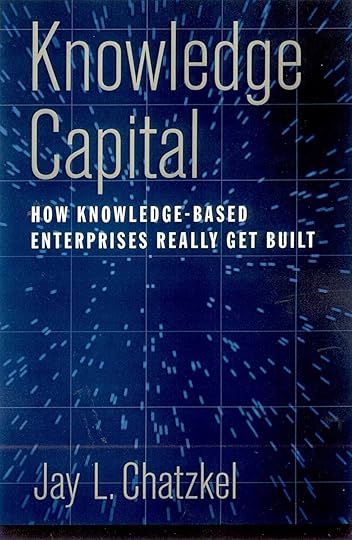
1. Introduction: Why Knowledge Capital?
KNOWLEDGE Cluster I: Starting Points
2. Operating as a Knowledge System, Dorothy Leonard
3. The Knowledge Business, Jim Botkin
4. The Knowledge Movement Emerges from Its Infancy, Karl Wiig
KNOWLEDGE Cluster II: Strategic Issues
5. Recipes for Knowledge-Based Value Creation, Göran Roos
6. The Intelligent Organization, Leif Edvinsson
7. Understanding the Enterprise as a System, Vince Barabba
KNOWLEDGE Cluster III: Human Capital, Values, and Learning
8. Human Capital Is the Only Active Asset, Jac Fitz-Enz
9. People Are the Owners and Investors of Human Capital, Thomas O. Davenport
10. Shared Values: The Prerequisite for Knowledge Sharing and Creation, Don Tyler
11. Learning in the Knowledge Era, Brook Manville
KNOWLEDGE Cluster IV: Drivers and Accounting for Intangible Wealth
12. Value Drivers for Intangibles, Jonathan Low
13. A Level Playing Field for Intangibles, Steven M. H. Wallman
KNOWLEDGE Cluster V: Bringing It All Together in Practice
14. Creating and Implementing a Knowledge Strategy, Hubert Saint-Onge
15. Knowledge Management Is about Change, Kent Greenes
16. Finding “the Hook”, Sharon Oriel
17. The Springboard Story, Stephen Denning
18. The Knowledge-Centric Organization, Alex Bennet
Epilogue: Convergence — Toward the Next StageTen Questions: Leading Your Organization into Becoming a Knowledge-Based EnterpriseWhat are examples of how knowledge has grown as a factor of production in your organization?What kinds of knowledge are key inputs in your organization’s goods and services offerings?How do you measure and report the value of your knowledge assets (from more directly measurable intellectual property to harder-to-measure intangibles, such as brand, the ability to respond, and so on)? Do these measures help guide organizational decision making and resource allocation?Is your organization moving to become a sense-and-respond enterprise? What is helping your organization move down that path? What is blocking you?What is your knowledge strategy? How was it created, and who is deploying it? How do you measure the effectiveness of your implementation?How do you make sure you include the necessary knowledge inputs in your organizational processes to ensure high levels of performance?What are the core shared values of your organization? How did you determine them? Who is responsible for ensuring that they are aligned with your knowledge strategy and your organizational goals?Who is part of your knowledge enterprise, and how do they link in your knowledge network (for example, senior leadership, middle management, supervisors, front line workforce, strategic partners/suppliers, customers)?How can you use springboard stories (how people successfully overcame obstacles through using knowledge-based interventions) as catalysts for knowledge sharing?How are you preparing for the future? Who is responsible for anticipating the needs of the next generation of customers and for developing the knowledge for prototyping responses to those needs?Resources: Books for Building a Knowledge-Based Enterprise Fast track route to understanding and exploiting intellectual capitalCovers the key areas of intellectual capital, from value-adding intellectual capital programs and value capture to finding the ‘hook’ and setting up measuresExamples and lessons from some of the world’s most successful businesses, including Dow Chemical, Rockwell International, Clarica, and Buckman Labs, and ideas from the smartest thinkers, including Karl-Erik Sveiby, Baruch Lev, Hubert Saint-Onge, Patrick Sullivan, Goran Roos and Leif EdvinssonIncludes a glossary of key concepts and a comprehensive resources guide
Fast track route to understanding and exploiting intellectual capitalCovers the key areas of intellectual capital, from value-adding intellectual capital programs and value capture to finding the ‘hook’ and setting up measuresExamples and lessons from some of the world’s most successful businesses, including Dow Chemical, Rockwell International, Clarica, and Buckman Labs, and ideas from the smartest thinkers, including Karl-Erik Sveiby, Baruch Lev, Hubert Saint-Onge, Patrick Sullivan, Goran Roos and Leif EdvinssonIncludes a glossary of key concepts and a comprehensive resources guideIntroduction to Express Exec
Introduction to Intellectual CapitalDefinition of Terms: What is Intellectual Capital?The Evolution of Intellectual CapitalThe E-DimensionThe Global DimensionThe State of the ArtIn Practice: Intellectual Capital Success StoriesKey Concepts and ThinkersResourcesTen Steps to Making Intellectual Capital WorkFrequently Asked Questions (FAQs)
[image error]May 3, 2024
Knowledge Management Thought Leader 68: Chris Collison
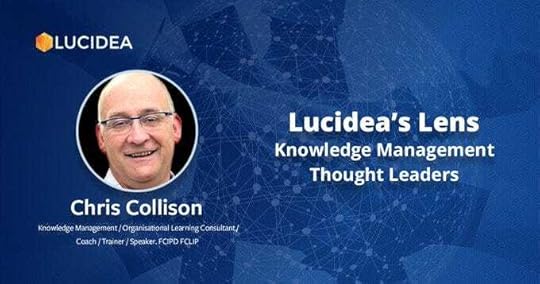
Chris Collison is a Knowledge Management consultant, coach, trainer, and speaker based in Ascot, Berkshire, United Kingdom.
He is the owner and director of Knowledgeable Ltd, where he works with a wide variety of organizations, helping them to improve their performance by discovering and sharing what they know.
Chris joined BP in 1989, occupying a series of positions in Research, IT and Organizational Development. In the late ’90s he worked as part of their acclaimed knowledge management team. Later, as part of BP’s Organizational Capability team, he became head of knowledge-enabling systems, and carried out research into innovation.
He later became Director of Change and Knowledge Management at Centrica. Chris serves as visiting faculty at Henley Business School, is an advisor to the International Olympic Committee, and is a Chartered Fellow of the Chartered Institute of Personnel and Development (CIPD).

For more about Chris, see Profiles in Knowledge.
Selected Books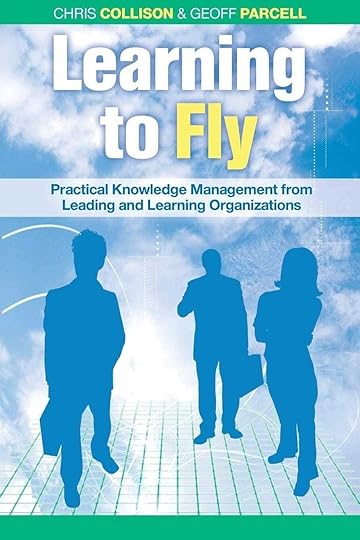

 What is Knowledge Management?
What is Knowledge Management?You can’t manage knowledge — nobody can. What you can do is to manage the environment in which knowledge can be created, discovered, captured, shared, distilled, validated, transferred, adopted, adapted, and applied.
To create an environment within which knowledge rapidly flourishes we need:
the right conditions: a common reliable infrastructure and an organization willing be entrepreneurial;the right means: a common model, tools, and processes;the right actions: where people instinctively seek, share, and use knowledge; andthe right leadership: where learning and sharing is expected and role-modelled.Start with the way your organization operates: People and teams agree a set of goals, and then use knowledge to deliver against their targets, ultimately creating value. So where do you begin to intervene with knowledge management?
Let’s focus on the “using knowledge” circle. What if you could inspire your organization to learn before, during, and after any significant activity? Simple learning processes like peer assists, retrospects (post project reviews), and after-action reviews make their contribution here, and help to elicit new knowledge — knowledge which would have remained in the heads of the individuals concerned.
All this learning activity needs to be connected to some kind of knowledge “bank”. To learn before doing, you will want to make a withdrawal — and when you have lessons learned to contribute, you’ll need to make a deposit.
That’s where the ability to capture and distill knowledge becomes important. But that’s not the whole story. You can’t capture everything, so it’s important to link to the people and network who hold key knowledge and insights, and to encourage them to own and update any knowledge which is made explicit — captured as information.
Surrounding this model is the environment or culture within your organization, which is critical to get started and sustain knowledge-sharing. This will be reflected in the right leadership behaviors, and the way in which KM becomes embedded into core processes so that ultimately it becomes an “unconscious competence”.
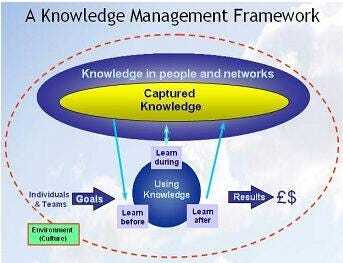 KM Self-Assessment
KM Self-Assessment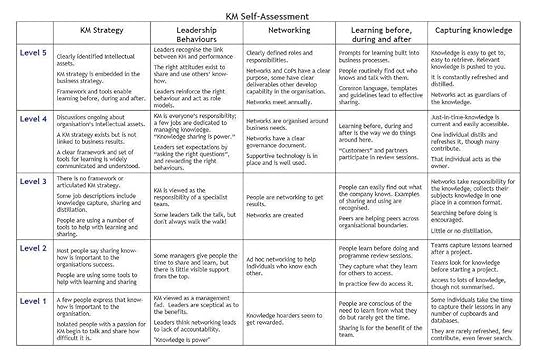 Knowing What Good Looks Like
Knowing What Good Looks LikeYou know knowledge is being effectively managed when there is:
Leadership. Leaders in the organization are role models, challenging people to ask for help, seek out, share and apply good practices. This inspires curiosity and a commitment to improve. The organization is learning!Learning. People instinctively seek to learn before doing. Lessons from successes and failures are drawn out in an effective manner and shared openly with others who are genuinely eager to learn, apply and improve. Lessons lead to actions and improvement.Networking. People are actively networking, seamlessly using formal communities and informal social networks to get help, share solutions, lessons and good practices. The boundaries between internal and external networks are blurred, and all employees understand the benefits and take personal responsibility for managing the risks.Navigation. There are no unnecessary barriers to information, which is shared by default and restricted only where necessary. Information management tools and protocols are intuitive, simple and well understood by everybody. This results in a navigable, searchable, intelligently tagged and appropriately classified asset for the whole organization, with secure access for trusted partners.Collaboration. People have the desire and capability to use work collaboratively, using a variety of technology tools with confidence. Collaboration is a natural act, whether spontaneous or scheduled. People work with an awareness of their colleagues and use on-line tools as instinctively as the telephone to increase their productivity.Consolidation. People know which knowledge is strategically important and treat it as an asset. Relevant lessons are drawn from the experiences of many and consolidated into guidelines. These are brought to life with stories and narrative, useful documents and templates, and links to individuals with experience and expertise. These living knowledge assets are refreshed and updated regularly by a community of practitioners.Social Media. Everybody understands how to get the best from the available tools and channels. Social media is just part of business as usual; people have stopped making a distinction. Serendipity, authenticity and customer intimacy are increasing. People are no longer tentative and are encouraged to innovate and experiment. The old dogs are learning new tricks! Policies are supportive and constantly evolving, keeping pace with innovation in the industry.Storytelling. Stories are told, stories are listened to, stories are retold, and experience is shared. People know how to use the influencing power of storytelling. Narrative is valued, captured, analyzed, and used to identify emergent patterns which inform future strategy.Environment. The physical workplace reflects a culture of openness and collaboration. Everyone feels part of what’s going on in the office. Informal and formal meetings are easily arranged without space constraint, and technology is always on hand to enhance productivity and involve participants who can’t be there in person.Embedding. Knowledge management is fully embedded in people management and development — influencing recruitment and selection. Knowledge-sharing behaviors are built into induction programs and are evident in corporate values and individual competencies. Knowledge transfer is part of the strategic agenda for HR. The risks of knowledge loss are addressed proactively. Knowledge salvage efforts during hurried exit interviews are a thing of the past![image error]April 26, 2024
Why Senior Leadership by Example is Important for Knowledge Management Success

The lack of C-level advocacy for knowledge management has always been a serious challenge for KM professionals.
In my recent post about Bob Buckman I stated that he is “one of the very few corporate CEOs to directly champion knowledge management, write about it, and actively participate in KM professional organizations.”
This post will explain why it is so important for top leaders in all types of organizations to not only advocate for KM, but to play an active role in practicing it.
Although it’s possible to implement a knowledge management program without the support of top leadership, it’s much more likely to succeed if you have it. Getting senior leaders to provide funding, demonstrate support, and lead by example are critical success factors.
Range of Executive Responses to Knowledge ManagementThere are five different types of responses to those who are trying to start or sustain a KM program.
1. Hostile
Some leaders actively oppose or undermine KM efforts. They may have taken over a leadership role and found a KM program already in existence. If they had no role in approving it, they might wish to cut back or eliminate it. This could be because of a previous bad experience, a lack of understanding, or a need to cut costs and show short-term profit improvement.
In Chapter 14: Apply Lessons Learned of my book Proven Practices for Promoting a Knowledge Management Program, I quote Richard Cross: Never trust someone who says, “Show me the ROI.” In every culture there are seemingly rational questions that mask hostile intent. “Can you show me the ROI?” generally falls into this category. Asking for demonstrable ROI could be an early warning sign regarding lack of their (or your) credibility.
Guaranteed ROI then becomes a respectable and convenient way to express concerns over consequences. It’s easier for leaders to tell you they have decided not to proceed with KM because of this rather than to explain issues such as mistrust; scars from mistakes made before; politics; hassle; not interested; risk to career or company, or the simple fact that they don’t like you.
You can try to overcome executive hostility using the proven practices in my book, but it may be impossible. If so, you can wait for a new executive to take over or move to another organization that is more supportive.
2. Neutral
Many leaders may not know much about knowledge management and will be neither supportive nor hostile. If they stay out of your way, you can make some headway, but it is much better if you can help move them to become supportive or participative.
3. Lip Service
Leaders may appear to endorse a KM program but in fact are only superficially supportive. For example, they may advocate usage of an enterprise social network, but then continue sending email. They may say, “Everyone should fill in their personal profiles,” but they have someone else fill in theirs. Instead of using a KM tool, they may delegate it to someone else. They may say they want a KM program but fail to allocate budget and resources for it.
This is slightly better than the previous two responses but can be difficult to overcome. The appearance of support is disingenuous, but if you explicitly confront it, this may result in denial, defensiveness, and diminished actual support.
4. Supportive
This response is valuable, and includes helpful funding, messaging, and management involvement with goals, measurements, and recognition. This can get a KM program going and help it progress, but it is one level short of the ideal.
5. Participative
Senior leaders who lead by example, practice what they preach, and model the desired KM behaviors are the most likely to help your KM program achieve its full potential. Executives and their staffs should not only communicate about key initiatives. They should actually participate themselves in a visible manner.
Employees are used to receiving messages asking them to adopt some new process or tool or to behave in a specified manner. They tend to ignore these requests unless there is some obvious benefit to them, they expect to be directly measured on compliance or punished for non-compliance, or they have a personal interest or emotional connection to the topic. A better way to get the attention of employees is to see top management directly using the process or tool or demonstrating a task they have asked others to perform.
Leaders who demonstrate they are willing to do the very thing they have asked others to do are likely to see other members of the organization follow their example. Members of the organization will watch the actions of their leaders. If they perceive that the message is “do as I say, not as I do,” they will be unlikely to do what is requested of them. But if employees observe management actually taking its own advice, they are much more likely to follow suit.
“Practice what you preach” is a good motto. Leaders who tell employees to join communities should visibly be active community leaders or members. If they want people to start blogging, they should blog regularly, solicit comments, and respond promptly to those comments. They should do this themselves, not through subordinates. To model the KM behaviors they want others to demonstrate, they should share, innovate, reuse, collaborate, and learn in an open and visible way.
Examples of Supportive and Participative Leadership for Knowledge ManagementThe best way for senior leaders to support and participate in KM programs is to make The 10 Commitments:
Approve a reasonable budget for people and other KM expenses.Ensure that all KM leaders have the time to do a good job in the role and are allowed to meet in person once a year.Learn how to give a KM program overview presentation.Learn how to use KM tools and use them to lead by example. Show everyone how easy it is to actually use the processes and technology.Communicate regularly about how the organization is doing in KM. It should be on the agenda for all meetings, con calls, and webcasts.Provide time during leadership team meetings and employee communication events for KM messages. The other leaders need to be reminded regularly of the importance of KM in achieving the organization’s goals.Ensure that KM goals are really set for all employees and are enforced. It’s not sufficient to communicate goals in a high-level message. They need to actually be assigned, monitored, and achieved.Inspect compliance to KM goals with the same fervor as for other key performance indicators. If KM indicators are reviewed along with the usual business metrics, it will be clear that they are just as important.Reward employees who share, innovate, reuse, learn, and collaborate. Rewarding desired behaviors provides positive reinforcement, offers motivation, and communicates to everyone how such behaviors are valued.Ensure that time is allowed for sharing, innovating, reusing, collaborating, and learning. Examples of Participative Leadership
Examples of Participative LeadershipAt HP, an internal blog platform was created as a skunkworks project by the imaging and printing group. Initial participation was limited to a few early adopters. Then the Executive Vice President of the group started an internal blog, and it was obvious that he was actually writing and posting himself, not through a ghost blogger. This triggered many members of the group to comment on his blog, create their own blog posts, and comment on each other’s posts. Morale increased because employees could see that their senior leader was soliciting their advice and reading and replying to their comments.
HP’s social networking profile (me@hp) gained a small number of users each week. When the Senior Vice President of the consulting business posted her profile and sent out a note to the entire organization about it, there was an immediate spike in new profile creation.
At Buckman Labs, Bob Buckman wrote notes to people in his company asking them, “What knowledge have you shared with your colleagues today?” He made it clear that only those who got with the new KM program would succeed. “The most powerful individuals in the future of Buckman Labs,” he said, “will be those that do the best job of transferring knowledge to others.”
[image error]April 20, 2024
Helen Lippell: Profiles in Knowledge

This is the 102nd article in the Profiles in Knowledge series featuring thought leaders in knowledge management. Helen Lippell is a taxonomy, search, metadata, and semantic modeling consultant. She says that she helps organizations sort out their messy content and data. Patrick Lambe posted a suggestion that I include Helen in this series, and I am glad to oblige.
She is experienced in designing information architectures, metadata schemas, taxonomies, and semantic models to help organizations fully exploit the value of their content. Helen has designed and implemented taxonomies for websites, intranets, content management systems, enterprise search solutions, and semantic publishing tools. She has tamed unstructured data including financial data, local news, entertainment listings, government information, and operational policing policies.
Helen’s specialties include managing search engines, taxonomy, metadata, content analysis, A-Z indexes, text analysis, search insight, search user experience, findability, information architecture, content audits, categorization, automatic classification, navigation model design, and content modeling. She works on taxonomy development projects, including taxonomy audits, ontology modeling, tagging initiatives, semantic publishing, knowledge graphs, and metadata training. She writes and speaks regularly and is the program chair of Taxonomy Boot Camp London.
Helen lives in London with cats and books. She has been a contestant on quiz shows such as Only Connect and Brain of Britain. She also attempted to visit all 270 London Tube stops in a single day.
Background EducationKeele University — Bachelor of Arts (BA), Latin and EconomicsExperienceInformation Today, Inc. — Program Chair, Taxonomy Boot Camp London, 2016 — PresentElectronic Arts (EA) — Taxonomy consultant, 2017–2021Pearson — Global Taxonomist, 2016–2017Metropolitan Police — Search Analyst. 2014–2015Press Association — Strategic Metadata Manager, 2012–2014Time Out Group — Taxonomy and Metadata Manager, 2011–2012Directgov — Metadata and Taxonomy Analyst, 2007–2011BBC — Information Architect, 2004–2007Financial Times — Index Development Manager, 1998–2003ProfilesLinkedInTwitterFacebookInstagramContentPosts and ArticlesLinkedIn PostsThe Metadata Model for DirectgovStoryline Ontology: An ontology to represent News StorylinesThe ABCs of the BBC: A Case Study and Checklist
EducationKeele University — Bachelor of Arts (BA), Latin and EconomicsExperienceInformation Today, Inc. — Program Chair, Taxonomy Boot Camp London, 2016 — PresentElectronic Arts (EA) — Taxonomy consultant, 2017–2021Pearson — Global Taxonomist, 2016–2017Metropolitan Police — Search Analyst. 2014–2015Press Association — Strategic Metadata Manager, 2012–2014Time Out Group — Taxonomy and Metadata Manager, 2011–2012Directgov — Metadata and Taxonomy Analyst, 2007–2011BBC — Information Architect, 2004–2007Financial Times — Index Development Manager, 1998–2003ProfilesLinkedInTwitterFacebookInstagramContentPosts and ArticlesLinkedIn PostsThe Metadata Model for DirectgovStoryline Ontology: An ontology to represent News StorylinesThe ABCs of the BBC: A Case Study and ChecklistEight-point checklist for creating terrific A-Z indexes
Know your audienceShow your numbersAcknowledge articlesInclude synonymsProperly index proper namesConsider your cross-referencesUse qualifiers and extra informationTake pride in the indexArticles by OthersA Mastermind of taxonomy by Research InformationSynaptica Insights by Vivs Long-FergusonBecoming a Taxonomist: Real Life Stories by Karen LoasbyI started my career without a clear idea of what I wanted to do but was lucky enough to start working life in the Financial Times. One of my very first tasks was to cut out articles from newspapers, stick them on a piece of paper and fax them to clients. I got blisters on my hands from using scissors all day, but it sparked a passion for information and findability, and I’ve never really looked back.
I then moved onto the manual indexing operation, applying index terms from taxonomies onto news articles. The articles came from sources across the world, and I enjoyed the challenge of working out what would be the best index terms to apply. I then moved onto working on the automatic indexing of the content, to provide the scale and consistency that humans couldn’t provide (manual indexers continued to work on high value news sources such as UK newspapers). I also discovered an interest in taxonomies and vowed to pursue that.
Next up was a short contract at the BBC creating a taxonomy of UK place names. The place names were sourced from a third party but the structure and effort to disambiguate them were all my own work, and I had a ball. I enjoyed creating an artefact that was going to be used in a new content management system where metadata was key to its potential.
I returned to the BBC shortly after this, and straight away got to play with a large taxonomy that powered the recommended links system of BBC Search. Again, I enjoyed working with a complex product to try and improve the experience for search users and to ensure that great Web content could be found.
I then went to Directgov, developing taxonomies and metadata to underpin the next phases of the Website, creating intuitive navigation and search, and laying foundations for the challenges of the semantic Web.
I have had strange looks when I tell people I’m a taxonomist, but once we get past the “is it stuffing animals?” conversation, I like to tell them that the job is about problem-solving, product design, user experience, playing with language and many other things. Whatever ups and downs I’ve had, I’ve never been bored by the work I do.
Ontology and Domain Modelling by Conrad TaylorTaxonomies and ontologies are quite strongly related. The difference, said Helen, is that while taxonomies are concerned with the relationships between the terms used in a domain (also defining which are broader, which narrow, which are equivalent and which are preferred), ontologies focus more on describing the things within the domain, and the relationships between them.
Compared to taxonomies, ontologies aspire to greater rigor in the semantic rules which tie entities together, and to a degree of logical formalism which, ideally, lets machines join us as partners in navigating the web of relationships and meanings, though the construction of ontologically founded Description Logics and the application of machine reasoning which follows those logics.
Taxonomies, ontologies — neither is inherently better: you choose what is appropriate for your business need. An ontology offers greater capabilities, and a gateway to machine reasoning, but if you don’t need those, the extra effort will not be worth it. The two can also be combined, where the ontology gives you the structure and the classes and allows for interoperability with other data sets, and the taxonomy provides the controlled vocabularies which help with navigation and search.
Some definitions
Class: this is a central concept in ontology work. A class groups together a set of things which have properties in common (at least one property, ideally more). Example: the class of ‘domestic cat’ (Felis sylvestris catus) groups together millions of individual cats around the world.
Because an ontology is designed to be functional within a particular domain of practice — it’s a business tool — different groups will define classes differently to match their purposes, even if they describe the same sort of thing. Helen’s example was that an ontology of animals for managing a zoo will require very detailed information on different species of animal. But if you’re running a pet shop, you can get by with a handful of categories of animal.
Subclasses are also recognized in an ontology. (Gerbils and guinea pigs are both rodents, and all rodents are mammals.) But ‘subclassing’ is not a matter of simple mono-hierarchies: cats are mammals, boas are reptiles and owls are birds, but all also belong to the class of obligate carnivores.
Instances is a term used to denote the individual members of a class. (‘Bilbo Baggins’ is an instance of the class of hobbits; The Battle of Lincoln, 1217 is an instance of the class of military conflicts.)
Relation or relationship: this refers to what links the different entities, whether those entities are instances, classes, or concepts. These can be as broad or as detailed as your business purposes demand. Helen confesses that quite often she just makes do with a relationship statement such as ‘is a [member of class]’, or ‘has’:
guinea pig [is a member of class] rodentCharlie [is a member of class] guinea pigGuinea pig [has] furstrong>Inverse relationships are those which can be read in both directions (‘Patty is the sister of Suzy’). Other relationships are reversible but with inversely matching terms: parent and child for example. And if the aim is to support machine reasoning such as in search and discovery, the ‘stupidness’ of machines may require any derived description logics to have more elaborate rules e.g. HasUncle = HasParent (who) HasBrother.
Attributes: these are properties of the entities, or indeed properties of the relationships (because relationships can also be treated as entities). Attributes might record features of the entity, characteristics, or parameters such as permissible data type (an example of a data type parameter for a credit card number is that it must consist of 16 digits). One attribute could be cardinality, where you specify whether an entity can be linked to multiple values, or there must be only one (a place might have a Welsh and an English name but can have only one OS map grid reference).
What are ontologies for?
Helen listed a number of business scenarios in which ontologies can be helpful — information retrieval, classification, tagging, data manipulation. She is doing a lot of work currently on an ontology that will help in content aggregation and filtering, automating a lot of processes which are currently manual/mental.
Some use cases from Helen’s career
A London listings magazine wanted to automate restaurant recommendations within an online app; the project created an ontology and linked algorithms. The criteria for recommendations took into account proximity, plus what kind of food, atmosphere, price range and so on the user preferred. Concepts were also linked in such a way that, for example, if someone had searched for Vietnamese restaurants, then Korean and other East Asian cuisines might additionally be suggested.An educational publisher is seeking to move away from the old textbook model for managing and presenting its content. At the same time, they want to get rid of a plethora of earlier-generation content management systems. This ongoing project aims to achieve a single content management platform, linked to a single ontology. This is helping to establish, for example, strict definitions for parts of books and parts of courses; outsourced digital assets such as stock photography; arrangements for content re-use; and associated rights management issues.A news agency wanted to get journalists to populate fields of metadata relating to the news stories it was curating — but with a user interface that would hide the complexity of what lay beneath! Helen worked on the UI aspect of the system, which incorporated Linked Data features. For example, if a journalist noted that a story had something to do with Doug Engelbart, the system would retrieve structured information about him from DBpedia, and also search across the agency’s own multimedia databases to pull in links to images, video etc.A video game producer surprisingly took up ontologies big time. Their ontology is around the domain of the video game: for a given title, it applies a model about which platforms it runs on, if it is part of a larger franchise, if there are special editions, who are the characters, what weapons you can buy ‘in game’, and so on. Their aim is to drive personalized content, and to intervene with pop-up suggestions: if you are stuck on a level, the game could suggest a weapon or tool you could buy to get you further on. Ultimately, of course, the aim is to make money from the gamers.Community: The Search NetworkSitePublicationsPresentationsSlideShareMake Enterprise Search Less BrokenMake Enterprise Search Less Broken
AnnoMarket — Cloud-based text analyticsAnnoMarket - Cloud-based text analytics
Optimize Intranet Search and TaxonomiesOptimize Intranet Search and Taxonomies
ConferencesISKO UKElegant, frictionless tools for metadata management — Recording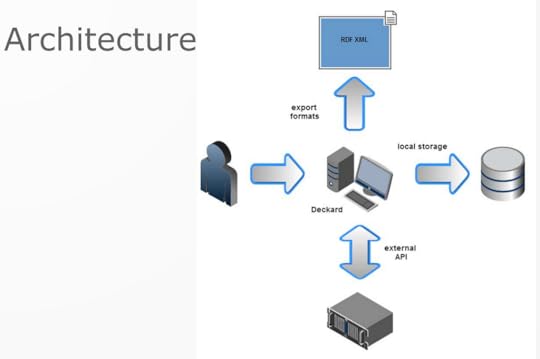 The paths from metadata to value
The paths from metadata to value Taxonomy Boot Camp2023 Taxonomy Showdown: Point/Counterpoint with Taxonomy Experts2022 Stump the Taxonomist2019 Raising the Profile of Taxonomy During ChaosBite-sized Taxonomy Boot Camp London2024Bite-sized Taxonomy Boot Camp BasicsTaxonomies in actionApril 2023Session 1 — What are taxonomies and why are they useful?Session 2 — Taxonomy project basicsSession 3 — Ask us Anything: Taxonomy Question TimeMarch 2023 Taxonomies in actionJune 2023 Taxonomies in actionOctober 2023 Taxonomies in actionOctober 2022 Practical tips for setting up taxonomy governanceJune 2022 Taxonomies in actionMarch 2022 Structuring a multi-faceted taxonomyNovember 2021 An incremental approach to knowledge graph building using taxonomies, ontologies & APIsJune 2021 Everything that will go wrong with your search, metadata or taxonomy projectMarch 2021 What’s Up Doc? Using a taxonomy to turn health news into cartoons2020 Taxonomies & Ontologies: where are we now and where are we heading?2019 Keynote — “That word you keep using? I don’t think you know what it means.”2018Keynote — This is the Bad Place: 13 rules for designing better information environmentsKeynote — Selling the benefits of taxonomy: numbers and stories2017 A201: Developing your career as a taxonomist2016 Making taxonomies visible and useful in the businessPodcastsDiving Head-First into TaxonomiesHarnessing the power of semanticsVideosTaxonomy interoperability — How to make it work wellhttps://medium.com/media/c11e0c6ef8770dde017b13a89269cd48/hrefOntologies, taxonomies and knowledge graphshttps://medium.com/media/618fb796ea6e32f964b656dfdcc397dc/hrefData bias, fake news and unethical informationhttps://medium.com/media/b6b3588576ec9d24b503f6a78ad37e8d/hrefIt’s Your First Day in a Taxonomy Job. Now What?!https://medium.com/media/a4b661077c69042b07331a3a45cb77ce/hrefThe Cloud — an LT Enabler?https://medium.com/media/783b14957c06583c80047668424ecaa0/hrefGoing virtual with Taxonomy Boot Camp Londonhttps://medium.com/media/cec263a22b89b11cf938f332ad5abd0b/hrefPublishing as a Practitionerhttps://medium.com/media/e59a6f3fbc10b641ddf2e9453405d37d/hrefHarnessing the power of semanticsBooksTaxonomies: Practical Approaches to Developing and Managing Vocabularies for Digital Information (editor)
Taxonomy Boot Camp2023 Taxonomy Showdown: Point/Counterpoint with Taxonomy Experts2022 Stump the Taxonomist2019 Raising the Profile of Taxonomy During ChaosBite-sized Taxonomy Boot Camp London2024Bite-sized Taxonomy Boot Camp BasicsTaxonomies in actionApril 2023Session 1 — What are taxonomies and why are they useful?Session 2 — Taxonomy project basicsSession 3 — Ask us Anything: Taxonomy Question TimeMarch 2023 Taxonomies in actionJune 2023 Taxonomies in actionOctober 2023 Taxonomies in actionOctober 2022 Practical tips for setting up taxonomy governanceJune 2022 Taxonomies in actionMarch 2022 Structuring a multi-faceted taxonomyNovember 2021 An incremental approach to knowledge graph building using taxonomies, ontologies & APIsJune 2021 Everything that will go wrong with your search, metadata or taxonomy projectMarch 2021 What’s Up Doc? Using a taxonomy to turn health news into cartoons2020 Taxonomies & Ontologies: where are we now and where are we heading?2019 Keynote — “That word you keep using? I don’t think you know what it means.”2018Keynote — This is the Bad Place: 13 rules for designing better information environmentsKeynote — Selling the benefits of taxonomy: numbers and stories2017 A201: Developing your career as a taxonomist2016 Making taxonomies visible and useful in the businessPodcastsDiving Head-First into TaxonomiesHarnessing the power of semanticsVideosTaxonomy interoperability — How to make it work wellhttps://medium.com/media/c11e0c6ef8770dde017b13a89269cd48/hrefOntologies, taxonomies and knowledge graphshttps://medium.com/media/618fb796ea6e32f964b656dfdcc397dc/hrefData bias, fake news and unethical informationhttps://medium.com/media/b6b3588576ec9d24b503f6a78ad37e8d/hrefIt’s Your First Day in a Taxonomy Job. Now What?!https://medium.com/media/a4b661077c69042b07331a3a45cb77ce/hrefThe Cloud — an LT Enabler?https://medium.com/media/783b14957c06583c80047668424ecaa0/hrefGoing virtual with Taxonomy Boot Camp Londonhttps://medium.com/media/cec263a22b89b11cf938f332ad5abd0b/hrefPublishing as a Practitionerhttps://medium.com/media/e59a6f3fbc10b641ddf2e9453405d37d/hrefHarnessing the power of semanticsBooksTaxonomies: Practical Approaches to Developing and Managing Vocabularies for Digital Information (editor) A Handbook for Corporate Information Professionals edited by Katharine Schopflin — Chapter 5: Developing corporate taxonomies
A Handbook for Corporate Information Professionals edited by Katharine Schopflin — Chapter 5: Developing corporate taxonomies New Horizons for a Data-Driven Economy: A Roadmap for Usage and Exploitation of Big Data in Europe edited by José María Cavanillas, Edward Curry, and Wolfgang WahlsterChapter 9: Big Data Driven Innovation in Industrial SectorsChapter 14: Big Data in the Media and Entertainment Sectors
New Horizons for a Data-Driven Economy: A Roadmap for Usage and Exploitation of Big Data in Europe edited by José María Cavanillas, Edward Curry, and Wolfgang WahlsterChapter 9: Big Data Driven Innovation in Industrial SectorsChapter 14: Big Data in the Media and Entertainment Sectors [image error]
[image error]
April 19, 2024
Knowledge Management Thought Leader 67: Shawn Callahan
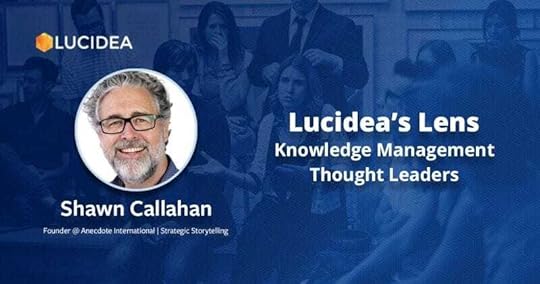
Shawn Callahan is based in Melbourne, Australia, where his company, Anecdote, applies inspirational story methods to business. He has helped some of the world’s top companies to make their strategies really stick. His specialty is helping analytically-minded executives find and tell the stories that engage the emotions of, and ultimately inspire action from, their employees and customers.
Shawn started out as a geographer and archaeologist before working in the field of information technology with Oracle and IBM. His story-work began in 1999 while at IBM, when he started applying complexity theory to business issues. Story-based approaches to corporate practice were definitely on the fringe, but that was soon to change.
In 2004, when Shawn founded Anecdote, he had one clear aim in mind — to use story-work to bring out the humanity in organizations. He has taught business leaders how to be effective storytellers, and collected powerful organizational stories that prompt employees to work out for themselves what needs to change.
Shawn’s specialties are storytelling, strategic communications, leadership development, and culture change.

For more about Shawn, see Profiles in Knowledge.
Books
 Spotting a Business Story
Spotting a Business Story
Stories have people doing things, including talking. If you hear someone’s name followed by what they did, or if you hear dialogue, the odds are you’re listening to a story. In fact, dialogue can only be delivered in a story — it’s a real giveaway.
A story is also a promise to share something the audience doesn’t know. To qualify as a story, there must be something in it that’s unanticipated. It doesn’t have to be a great insight, but the listeners should at least raise their eyebrows a little. That’s what makes it story-worthy.
Lastly, to be a business story, a story must have a business point.
Avoiding change management failure using business narrative with Andrew Rixon and Mark Schenk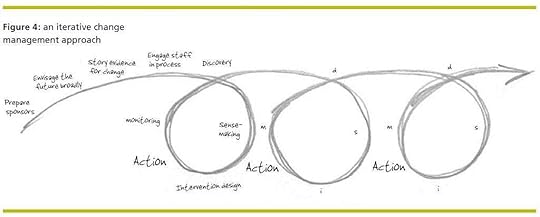 The Ultimate Guide to Anecdote Circles: A practical guide to facilitating storytelling and story listening with Andrew Rixon and Mark Schenk
The Ultimate Guide to Anecdote Circles: A practical guide to facilitating storytelling and story listening with Andrew Rixon and Mark SchenkCrafting Story Questions

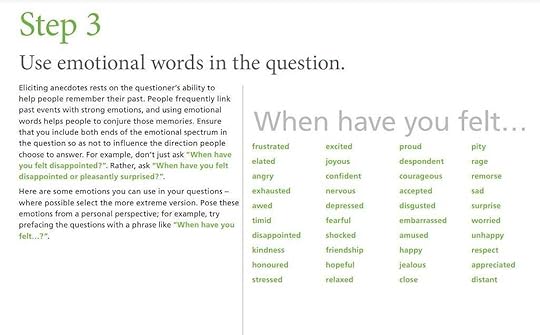
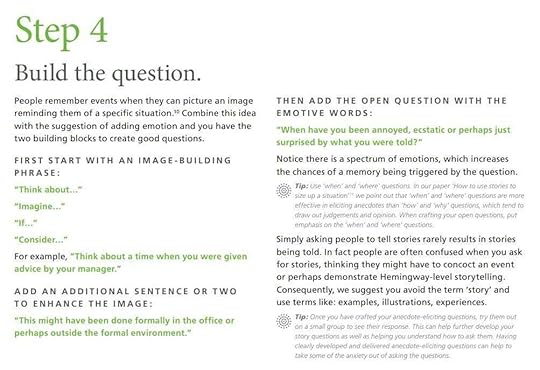 [image error]
[image error]
April 12, 2024
Knowledge Management Thought Leader 66: Bob Buckman
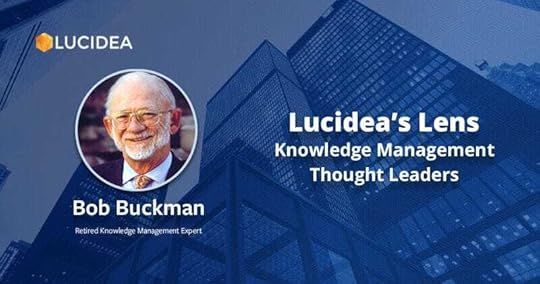
Bob Buckman is one of the very few corporate CEOs to directly champion knowledge management, write about it, and actively participate in KM professional organizations such as APQC.
He had a keen interest in knowledge management and knowledge sharing. Bob practiced and led these from 1984 until he retired in 2016, both within his own company and through teaching others around the world.
From 1977–2000 he was the Chief Executive of Buckman Laboratories, a leader in the specialty chemicals market. Bob was President and Chairman of the Board of The Applied Knowledge Group, Inc., a professional services firm, from 1999–2016.
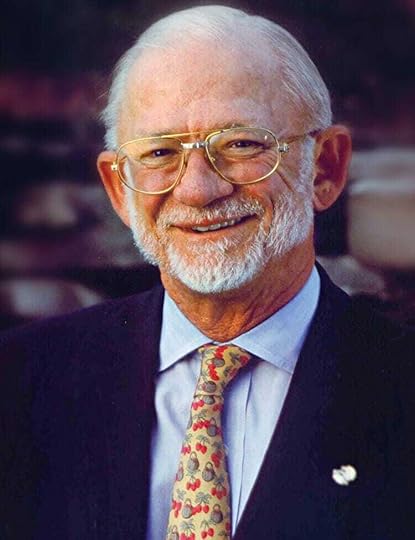
For more about Bob, see Profiles in Knowledge.
Book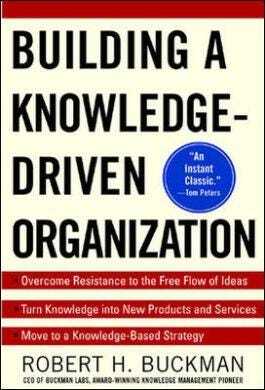 KM’s father figure: Robert Buckman: ‘Chaos makes serendipity’ in the KM world — interviewed by Jeff Angus
KM’s father figure: Robert Buckman: ‘Chaos makes serendipity’ in the KM world — interviewed by Jeff AngusNo one can lay claim to originating the term knowledge management, but a big share of credit goes to the person who first turned the concept into a highly functional, industrial-grade reality: Robert Buckman, retired CEO of Buckman Labs, a Memphis, Tenn.-based chemical company with approximately 1,400 employees in 80 countries.
Q: Your company was founded in 1945; when did you start applying KM to your business?
A: We somehow got stuck with this term knowledge management. We never used that term. We don’t have a CKO. We have a lot of people who are “knowledge officers” because that’s what they do. We started that work seriously in 1984, fooling around with using desktop computers as tools. Desktops didn’t work out well because we wanted to have our knowledgeable people in the field with our customers. Laptops, even the 17-pound ones, were better and freed people from having to be at the office but still have access to all the knowledge of the people at the company.
Q: What was your goal with this KM experiment?
A: We were trying to radically improve our abilities to solve customer problems better and faster, to redefine our competitive position. It was essential — it still is — that we redefine the time equation of work. Back then, we would ship Ph.D.s all over the world to transmit knowledge. It wasn’t viable. It was very expensive, but worse, it didn’t move fast enough. Really, what we do this for is to redefine the speed at which we get work done.
We had a breakthrough in 1992. We built systems for transmitting knowledge on top of CompuServe forums, threaded discussions.
Q: What were the first benefits?
A: We radically improved our speed of new product development. Before it had been 13 to 18 percent a year new products, and with this CompuServe setup we were at 30 to 35 percent.
Q: So you measure effectiveness as a new-product-sales ratio?
A: Not anymore. That’s a good metric for a product-driven organization, but now we’re knowledge-driven. We’ve evolved to a different relationship with our customers, more of a partnership. We don’t just ship them chemicals, we ship them knowledge of how to use them, or sometimes we take over a whole operation for a customer, assuming responsibility for their technical department, equip it, staff it. We measure our effectiveness in getting $X per month on a product, not $X per pound.
But when you build that kind of company, you have to do it on a basis of trust, or you create no value. If you hire the right people, 99.9 percent of them want to do the right thing. And when that’s the case, you don’t design systems on the basis of the 0.1 percent who don’t. Open systems make the smoke blowers obvious, and they soon disappear. The problem with so many organizations is they’ve become involved in command and control and they’re too afraid to be able to benefit. Chaos makes serendipity.
Q: So in this permafrost economy, is KM a luxury you can afford?
A: You have to think about using knowledge to accelerate speed to reduce costs in this environment where you have no pricing ability. You have to get better teamwork function, collaborate better, no matter what tools you use to get there. It’s a little easier for us than most companies because we’ve done it before, but we’ve never needed it as much as we need it in this environment.
Technology still imposes limits. Microsoft has to figure out how to get effective people collaboration in Office, for example. The key thing is to figure out how to redefine the timing questions of work. If we don’t do that, we won’t get the cost improvements that will improve our standard of living, and all the white-collar work will move offshore.
Those are the issues we have to figure out. We’re going to have continual economic pressure to do things better and faster.
A Conversation with Bob Buckman by Luis Suarez“Don’t be afraid to share what you know, because you know it better than anyone else!”
“Don’t be afraid to steal stuff — Reuse!”
“In the future we will spend more money in the transfer of knowledge than in hardware and software!”
A successful KM strategy is that one that helps improve the way knowledge workers share information internally so that we can then start collaborating and sharing our knowledge with customers:
Defining expectations from the customerDefining how customers would measure youAnd asking ourselves, are we capable? (Understanding the value of reputation!)Bob mentioned how crucial the role of librarians is for knowledge management, especially for the case of small businesses competing with much larger corporations. These librarians should oversee full text knowledge bases that capture all the critical knowledge that other knowledge workers are sharing.
He also mentioned how crucial communities will become in helping spread that knowledge and empower knowledge workers to collaborate with one another. The more cross-enterprise the community, the more innovation will be taking place, all of this by creating a knowledge-sharing culture using technology as an enabler, to help foster global reach.
Why KM Is More Fun Than Restructuring by Carla O’DellThe Knowledge that resides in the heads of your people is the most dynamic asset that you have. It is always changing, always growing in both quantity and quality. A key question is how should it move to satisfy the needs of the organization? Because it is this dynamic movement that results in new value creation.
In a typical Command and Control Structure knowledge moves up and down the organization in a sequential manner from one person to another. But this movement creates its own problems.
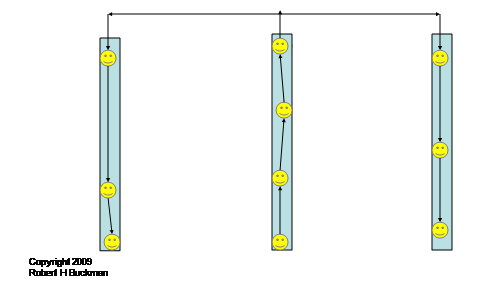

Knowledge deteriorates as it moves through different individuals in a sequential manner. Information is gathered on the front line, passed to some manager so that he can put his perception on the situation and so forth up the line, going from inbox to inbox until it gets to some guru somewhere, who puts his infinite wisdom on the situation and sends it back to the front line. No wonder there is confusion. In addition, this sequential communication model is a very slow process. While we cannot eliminate the command-and-control management structure in most organizations, we can poke holes in the silos and establish a networked model of collaboration.
[image error]


